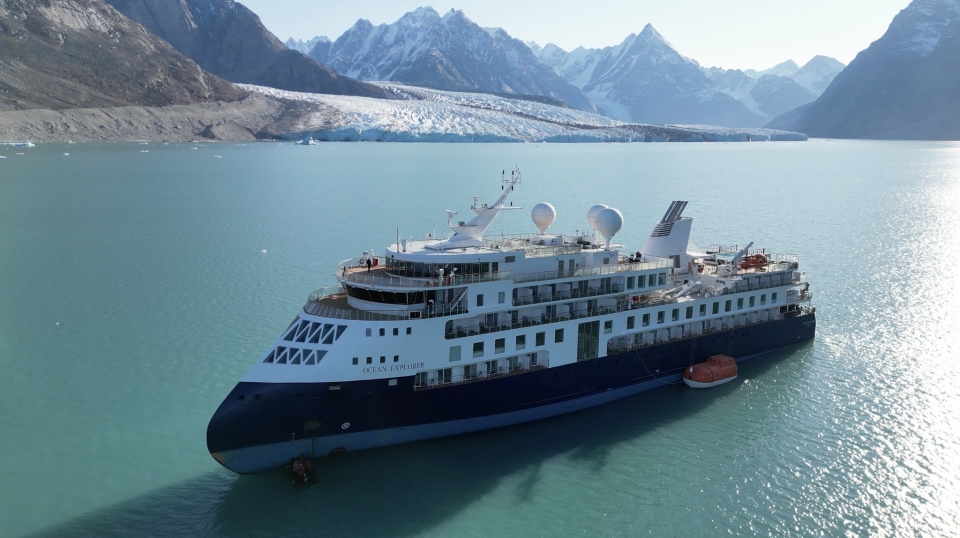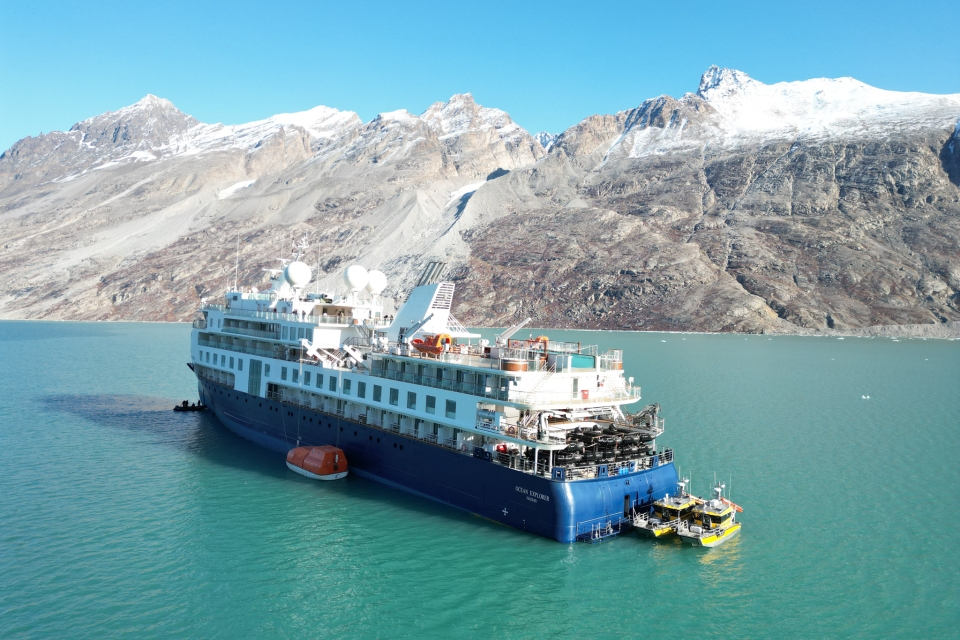The expedition cruise ship Ocean Explorer ran aground in Alpefjord, in the national park in Northeast Greenland, on Monday afternoon. The Danish Joint Arctic Command reports a first refloat attempt has failed.
On Monday afternoon, 11 September, West Greenlandic time, Arctic Command received a message that the cruise ship Ocean Explorer had run aground in Alpefjord and that the ship was not immediately able to free itself.
There are 206 passengers and crew members on board the Ocean Explorer. There have not been any injuries as a result of the grounding. It has also been announced that there is currently no damage that could pose a risk to the environment, says Head of Operations at Joint Arctic Command, Commander Brian Jensen.
Jensen: ‘A cruise ship in trouble in the National Park is of course worrying. The nearest help is far away, our units are far away, and the weather can be very unfavourable. However, in this specific situation, we do not see any immediate danger to human life or the environment, which is reassuring. We are, of course, following the situation closely and taking this incident very seriously.’
Knud Rasmussen en route
Arctic Command’s closest unit is the inspection vessel Knud Rasmussen, which at the time of the report was approximately 1200 nautical miles from the cruise ship. This means that the earliest the Knud Rasmussen can reach the grounded ship is Friday morning local time. However, the weather may play a role. The vessel is currently en route.
‘As soon as we realised that the Ocean Explorer could not get free on its own, we sent a ship towards the wreck,’ states Jensen. ‘We have reached out to relevant partners in the area of operations to investigate whether other units may have a shorter and faster route to the grounded ship.’
Also read: Dutch sailing ship with students grounds off Norway
Other cruise ship to stay close
The co-operation in the Arctic means that it is possible that the Icelandic Coast Guard will be asked for support. Arctic Command has also been in contact with another cruise ship that is in the vicinity of Ocean Explorer. This ship has been asked to remain in the area to assist should the situation develop.
There are other ships in the vicinity of the Ocean Explorer. Should the need arise, Sirius (a Danish naval unit) personnel can be at the wreck site within one and a half hours.
First refloat attempt fails
Right now, there are several scenarios for how Ocean Explorer can be helped, says Jensen. ‘They can either try to get out on their own when the tide is high, they can get help from a nearby cruise ship, they can get help from Knud Rasmussen, or they can get help from one of our partners. No matter what, the most important thing for us is that everyone is safe.’
A first refloat attempt took place on Tuesday during the day when the tide was high, but to no avail so far.
According to CTV News, a scientific fishing vessel owned by the Greenland government is scheduled to arrive later on Wednesday and together with the high tide will try to pull the Ocean Explorer free.
Sirius personnel boards cruise ship
To get the best possible impression of the situation, Arctic Command has had personnel from Sirius on board the grounded cruise ship. Although the situation is difficult, Arctic Command says it has now been assured that the crew and passengers of the cruise ship are safe and sound: ‘The crew and passengers are in a difficult situation, but under the circumstances, the atmosphere on the ship is good and everyone on board is well. There are no signs that the ship has been seriously damaged by the grounding.’
The Government of Greenland, the Danish Maritime Authority and the Danish Accident Investigation Board have been informed of the incident.
UPDATE 14 SEPTEMBER:
Yesterday morning (local time), the Institute of Natural Resources’ fish research vessel Tarajoq, owned by the Government of Greenland, arrived at the grounded cruise ship. After initial investigations and contact between the two ships, Tarajoq attempted to pull the Ocean Explorer off the ground at high tide but without success.
It remains Joint Arctic Command’s first priority to get the inspection vessel Knud Rasmussen to the wreck. However, due to the weather in the area where Knud Rasmussen is located, the vessel has had to slow down slightly. The ship is now expected to arrive during the evening of Friday 15 September.

Ocean Explorer
The Ocean Explorer was built in 2021 and is part of the Infinity Class vessels designed by Ulstein. The vessel is 104.4 metres long and 18.4 metres wide and features an Ulstein X-Bow. The vessel is operated by Aurora Expeditions.
Photo (top): Sirius/Arctic Command
Also read: No more HFO in Arctic waters from 2024








